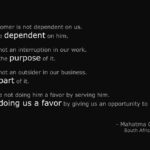This article first appeared in Commerce and Industry Magazine Vol 2 No 008 August 2013
When we conjure up images of well blended bone soup with the marrow and herbs all fused into a great tasting broth, the elements that make the sum total of the whole evoke a very warm feeling. When we list the terms customer service and the manufacturing industry side by side in pot, there seems to be some incongruence. No warm feeling emanates and the two are not seen to fit together like hand and glove as is the case with companies dealing directly with customers like those in the hospitality industry, banking, insurance or other retail sectors.
What comes to mind when we think of ‘manufacturing’ is lines, conveyor belts, machines, processors and power; all hard, cold, mechanical and functional elements. But giving it serious thought, we actually need to reconsider the fundamental role customer service plays in this industry. And as remote as it sounds with regards to the subject, customer service should in reality form the pivot around which manufacturing spins.
Let’s for starters take a look at the definition of manufacturing from various sources. ‘Manufacturing is the use of machines, tools and labor to make things for use or sale’, ‘To make or process raw material into a finished product’ and ‘To make or process goods, especially in large quantities by means of industrial machines’. All these definitions have once common denominator – end product. And naturally therefore, we ask the leading question about who this end product is ‘produced’ or ‘manufactured’ for. Yes – The Customer.
Why then is the end customer not given due recognition by the industry? To further explore this subject, I conducted a small poll amongst a sample group from my friends, colleagues and family and asked what they’d do if they found one of the manufactured products they’d bought had a problem. Many were not sure if they’d return the item to the supermarket or store where they bought it from or if they’d try and contact the manufacturer. What was clear however was that the procedure for complaint was definitely unclear. Not one single person knew firmly what action to take in event of a product defect. When we juxtapose this with the service industry, it pales in comparison as there, aggrieved parties are very quick to escalate service failure to the supervisor or manager in charge.
I was inspired by these interesting results to further carry out an inspection exercise of the various manufactured goods on our super market shelves, to discern if the existing communication advises customers of what to do in event they encounter a product issue. My scrutiny included a wide range of products including food products, a host of detergents, pet food, spices, toilet paper, beauty products and household goods. Much to my consternation, the products all have insufficient information on this subject.
Most products had only the address and telephone contacts of the manufacturer under a title ‘Manufactured by’ or ‘Produced and packaged by’. Some had gone a little further to label the telephone lines ‘customer care’ lines and the closest to being remotely advisory, was on a box of cereal that read “in event of a problem with this product please return it with the label indicating the sell by date to our customer service department”. It didn’t have specifics of their physical location or the location of the said customer service department. Three items had a toll free 0800 number that I called and didn’t get through in two cases and in one case the number went unanswered. These unstructured findings of my dipstick poll had me seriously consider preparing a proposal to interest our vibrant research firms to conduct a proper survey on the customer response mechanisms for our manufactured goods.
That all said, the question that still baffles, is how the manufacturing industry is driving change and innovating for the customer. There exists a concerted effort to check on quality control for products with in situ quality control departments, but what actually informs the initiatives in place to repackage, re-invent and revive products? How do they tap into customers’ direct feedback to assess the uptake of products and what needs to be done to tweak them to serve the emerging needs? How does the industry innovate? It is said that innovative thinking is looking at the customer’s routine outside the company’s existing products and then innovating to add value. How then should the manufacturing industry look at the customer and hear them first hand?
Having explicit information on product packaging on how to report a defect, complete with legit contact details should be the first and mandatory step. This packaging should also encourage other regular feedback to institute direct communication that enables the manufacturer hear straight from the ‘horse’s mouth’. This initiative would also have the added spin off of easier identification and reporting that would boost the government’s effort to curb the influx of sub-standard, counterfeit and contra-band good, as customers would be the first to call in to report fake products.
And although players in the manufacturing industry often view their main customers as the distributors and seek to streamline their orders, logistics and supply issues, the heartbeat remains unchecked. The 2011 study from Deloitte on Global Manufacturing Industry Practice says “The business model of global manufacturers is under attack due to changing customer demands. Confronted by competitors, escalating complexity of supply chains and ever-increasing customer demands, manufacturers ignoring the needs of the service business do so at their peril”. The customer indeed needs to be at the centre of it all.
Given these observations and projections, the manufacturing industry in Kenya needs to rethink their service delivery strategy and build in communication streams that directly flow from the customer. Where applicable, a mechanism to channel back feedback provided to distributors in the supply chain should be built in.
With Kenya’s current economic lift off, manufacturing is among the key productive sectors identified for economic growth and development. This is attributed to its centrality to creation of economic stimulus, and the anticipated jobs for the youth in the counties countrywide, to alleviate poverty. It is therefore both our individual and collective responsibility to add value to the sector as an area that spurs growth towards the country’s achievement of Vision 2030 goals with specific reference to the economic vision in chapter 4 section 4.4 that challenges the nation to manufacture for the entire region.
So to all manufacturer s out there – I challenge you to ‘talk’ to your consumers and to all consumers out there – agitate to ‘talk’ to your manufacturers.






